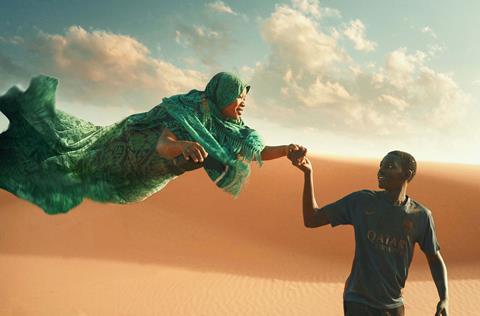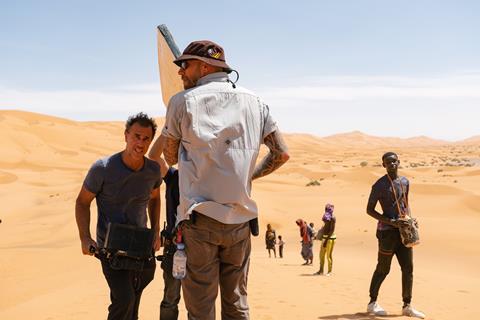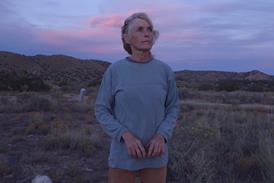Two Senegalese teenagers risk everything to reach the promised land of Europe in Io Capitano, a stirring and topical drama from Italy’s Matteo Garrone. Screen talks to the director about his Oscar-nominated feature.

In Matteo Garrone’s Io Capitano (I Captain), Seydou (Seydou Sarr) and Moussa (Moustapha Fall), two Senegalese teenage boys dreaming of a better life in Europe, make a perilous journey from the west of Africa to Sicily. Travelling by bus, car, lorry and foot through Mali, Niger and Libya before crossing the Mediterranean sea, their dangerous passage is plagued by human traffickers, corrupt border guards and criminals who steal their money, subject them to torture and sell them into modern slavery.
Io Capitano won Garrone a Silver Lion for best director at Venice Film Festival last September as well as the best young actor prize for Sarr. The film is nominated for best international feature at the Oscars, a first for Garrone who failed to secure nominations with Italy’s previous submissions to the Academy of his Gomorrah in 2009 and Dogman in 2019. “Finally,” he says, with a mixture of happiness and relief when Screen International speaks to him in January, just after the nominations were announced. “I’m getting old!”
Two months earlier, the director was a guest at Marrakech International Film Festival, returning to Morocco which he had doubled for Niger and Libya in scenes where Seydou and Moussa cross the Sahara. “I shot in Erfoud, in Rissani and in the desert,” says Garrone. “It was tough to shoot [because of the heat]. The scene with the Jeep was dangerous. It’s an adventure movie — it needs scenes with action, and sometimes that’s dangerous.”
The scenes set in Libya were also filmed in Morocco, recreated in a suburb of Casablanca, while a Casablanca prison was used for a later sequence in which Seydou is held captive, an episode based on a real-life migrant’s testimony.
In all, three true-life tales were combined to createIo Capitano’s overarching narrative, with the final section taking its cue from the story of Fofana Amara, a courageous 15-year‑old who sailed a boat with 250 people on board safely into Italian waters. In the film, Seydou is separated from his friend, but they are reunited by the time he agrees to pilot a boat full of migrants on the last stage of their odyssey to Italy.
“To shoot in a boat is always very difficult, and with 100 migrants it was tough,” says Garrone. “But it’s a movie that tries to show how human rights are completely abolished, so to be in a situation of difficulty gives something realistic to the movie.
“We were shooting in situations at the limit and that helps the movie be more authentic and more real,” he continues. “To shoot with real people who [have] made the journey is a privilege that was very important.”
Neither Sarr nor Fall — both aged 17 when filming began — had been out of Senegal before, and Garrone hoped to use their lack of worldly experience to the film’s advantage. But it didn’t always turn out the way he planned. “I shot the movie in a chronological way, so they didn’t know about the script. Like the characters, they hoped to succeed because they wanted to discover Italy. Finally, when we arrived in Sicily for the last two-and-a-half weeks of shooting on the boat, we were in a hotel with a lot of comfort and a swimming pool. So they arrived in Italy two-and-a-half weeks before their characters, and it was difficult for me to recreate the same tension for the rest of the movie. I had to discuss with them, ‘We haven’t arrived yet, so please keep concentrated; the movie is not finished.’ They were too relaxed in the last part because they were [already] in Italy.”
The subject of immigration is one Garrone has addressed before, in his 1996 debut feature Land In Between, an expanded version of his short Silhouette that told of migrants from Nigeria, Albania and Egypt eking a living in his home city of Rome. When Garrone decided to return to the topic 25 years later, he knew a different viewpoint was needed.
“We wanted to make a movie where you have a subjective experience from the point of view of the migrant,” he says. “I tried to be an intermediator and put myself at the service of the story. It’s the reverse shot of what we are used to seeing and the opposite of my first movie, in which I used migrants to say something about Italy. Io Capitano ends when the migrants reach Italy; it’s a contemporary epic that is only about Africa, with parts in the middle that resemble a dark fairytale.”
Despite the film’s underlying seriousness, Garrone has imbued Io Capitano with elements of fantasy and magical realism. “The moment [with the floating woman] was important to tell how [Seydou] starts off as a kid and arrives as a man, completely changed,” explains Garrone. “During this journey he goes through moments of trauma — and to show the shock that he goes through it was necessary to show this as a dream.”
Casting the leads

Garrone’s previous fairytales — his 2015 portmanteau film Tale Of Tales and his 2019 adaptation of Pinocchio — have boasted an array of familiar faces, including Salma Hayek, John C Reilly and Roberto Benigni. For Io Capitano, though, Garrone put his faith in two untested Senegalese newcomers, one of whom initially chose a football match over his audition. “Seydou’s dream is to become a soccer player, so on the morning of the audition, he went to play soccer instead. When his sister found out he didn’t go, she went to the football camp to get him.”
When Sarr finally arrived for the audition, he was told it was full, only to return later to look for a key he feared he had dropped. This time, the casting team relented and let him audition for a role that would go on to win him the Venice prize. “If you put that in a movie, it would not be believable,” says Garrone, who praises Sarr’s performance for “an authenticity that goes straight to the heart of the audience”.
Fall’s casting was more straightforward, the budding musician and designer having attended acting classes in Dakar.
Garrone shot most of the movie in Senegalese language Wolof, which was “tough for me because I didn’t understand what they were saying”. Io Capitano’s three-month shoot in Africa and Italy in 2022 also saw Garrone work with a number of his regular collaborators — including production designer Dimitri Capuani, sound technician Maricetta Lombardo and editor Marco Spoletini — as well as a new director of photography in veteran Paolo Carnera, whose work on films such as Nostalgia, Suburra and Bad Tales had seen him nominated for six David di Donatello awards in Italy.
“He was great as a cinematographer and as a human being,” says Garrone. “I was lucky to find him. We shot in extreme situations, and he was always so human and sweet. He was also very fast, and whenever things were difficult, he always tried to find a positive solution.”
For a film with unknown leads speaking a combination of French and Wolof,Io Capitano was, says Garrone, surprisingly easy to finance. “I have a very good relationship with Rai Cinema in Italy, [French studio] Pathé immediately believed in the movie, and I found another co-producer, Tarantula, in Belgium.” Moreover, he says, “Pinocchio was a hit in Italy, so that made financing easier.”
WithIo Capitano’s European box office currently standing at $6.4m, the future looks promising for a film that Cohen Media Group will launch in North America on February 23. In the UK and Ireland, Altitude has scheduled it for April 5. Given the subject matter, Io Capitano is bound to generate local media interest, particularly with the UK’s Conservative Party making ‘Stop the Boats’ a key pledge in the run-up to an expected general election later this year.
Garrone is aware of the UK government’s hardline stance on immigration and views it as a futile attempt to stem an unstoppable tide. “Everybody should have the right to move freely like you and I do, without risking their life in the desert or the sea,” he says. “You can’t stop young people by closing borders or building a wall because they will try to do it anyway. All it will do is increase the deaths and make the traffickers of human beings richer. We should reflect on the consequences of this system and go in another direction.”

























No comments yet